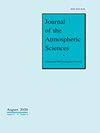具有向下倾斜非绝热强迫和海洋表面阻力的模式中热带气旋样涡的增强率
IF 2.8
3区 地球科学
Q2 METEOROLOGY & ATMOSPHERIC SCIENCES
引用次数: 0
摘要
热带气旋在成为全强度飓风之前,通常会有明显的垂直错位。热带气旋的垂直错位(倾斜)通常与内部核心对流的明显不对称有关,最强对流倾向于向表面涡旋中心的倾斜方向集中。无论是倾斜热带气旋增强的机制,还是这种机制运行的时间尺度,都没有得到充分的了解。本研究通过在三维非流体静力数值模型中考察倾斜的热带气旋状涡旋对下倾非绝热强迫(加热)的响应,对非对称增强过程提供了一些见解。加热的幅度可以调整,以改变其产生的向下倾斜对流的强度。在不同的模拟组中发现了相当一致的强化图像,这些模拟组在初始涡流配置、环境剪切流和向下倾斜加热的特定位置方面有所不同。强化机制通常取决于在向下倾斜热源附近产生的低水平收敛σb是否超过临界值,该临界值取决于随热源漂移的参考系中低水平非分散背景流的局部速度。超临界σb引起由下倾角堆芯置换引起的快速自旋上升。亚临界σb导致一个较慢的强化过程。如本文所测,超临界强化速率与σb近似成比例。亚临界强化率具有更微妙的标度,当σb下降到摩擦自旋下降占主导地位的阈值以下时,预计会变为负值。讨论了上述结果与现实世界热带气旋的相关性。本文章由计算机程序翻译,如有差异,请以英文原文为准。
Intensification Rates of Tropical Cyclone–Like Vortices in a Model with Downtilt Diabatic Forcing and Oceanic Surface Drag
Tropical cyclones are commonly observed to have appreciable vertical misalignments prior to becoming full-strength hurricanes. The vertical misalignment (tilt) of a tropical cyclone is generally coupled to a pronounced asymmetry of inner-core convection, with the strongest convection tending to concentrate downtilt of the surface vortex center. Neither the mechanisms by which tilted tropical cyclones intensify nor the time scales over which such mechanisms operate are fully understood. The present study offers some insight into the asymmetric intensification process by examining the responses of tilted tropical cyclone–like vortices to downtilt diabatic forcing (heating) in a 3D nonhydrostatic numerical model. The magnitude of the heating is adjusted so as to vary the strength of the downtilt convection that it generates. A fairly consistent picture of intensification is found in various simulation groups that differ in their initial vortex configurations, environmental shear flows, and specific positionings of downtilt heating. The intensification mechanism generally depends on whether the low-level convergence σb produced in the vicinity of the downtilt heat source exceeds a critical value dependent on the local velocity of the low-level nondivergent background flow in a reference frame that drifts with the heat source. Supercritical σb causes fast spinup initiated by downtilt core replacement. Subcritical σb causes a slower intensification process. As measured herein, the supercritical intensification rate is approximately proportional to σb. The subcritical intensification rate has a more subtle scaling, and expectedly becomes negative when σb drops below a threshold for frictional spindown to dominate. The relevance of the foregoing results to real-world tropical cyclones is discussed.
求助全文
通过发布文献求助,成功后即可免费获取论文全文。
去求助
来源期刊

Journal of the Atmospheric Sciences
地学-气象与大气科学
CiteScore
0.20
自引率
22.60%
发文量
196
审稿时长
3-6 weeks
期刊介绍:
The Journal of the Atmospheric Sciences (JAS) publishes basic research related to the physics, dynamics, and chemistry of the atmosphere of Earth and other planets, with emphasis on the quantitative and deductive aspects of the subject.
The links provide detailed information for readers, authors, reviewers, and those who wish to submit a manuscript for consideration.
 求助内容:
求助内容: 应助结果提醒方式:
应助结果提醒方式:


